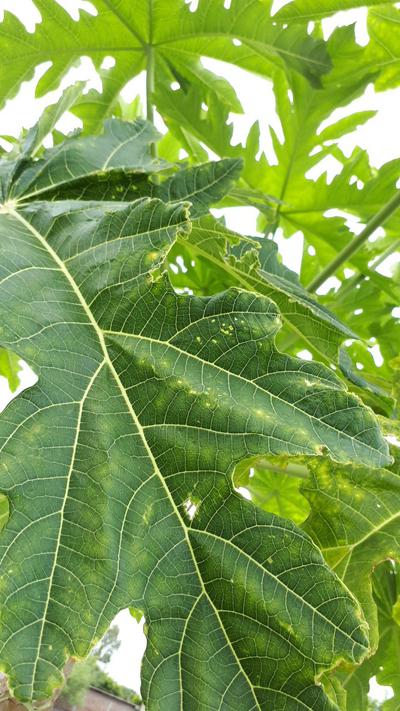Papaya Brown Spot
Corynespora cassiicola
Kuvu
Kwa Ufupi
- Small brown spots appear on older leaves and gradually move upwards.
- Spots enlarge and turn light gray with a dark margin and a yellow halo.
- Their center can become necrotic and fall out (shot-hole).
- Brown sunken-in spots may appear on fruits during wet weather.
Inaweza pia kupatikana kwenye
Dalili
Initially, small angular brown spots appear on the older leaves and move gradually upwards. With the progression of the disease, the spots enlarge and turn light gray with a dark margin, the whole surrounded by a yellow halo. Their center can become necrotic and fall out (shot hole), giving the leaf a ragged aspect. In wet conditions, the spots grow much larger and join together, developing a target-like aspect. Elliptical, dark brown spots may also occasionally appear on petioles and stalks. Usually fruits do not develop symptoms, but in some cases, brown sunken-in spots may appear during prolonged wet weather
Mapendekezo

Udhibiti wa Kiasili
Extracts of essential oil of Ceylon cinnamon (0.52 μL/mL) can be applied to control the size of the lesions on the leaves. It is very important to treat the crops before the fruits are infected, otherwise the treatment has no effect.

Udhibiti wa Kemikali
Always consider an integrated approach with preventive measures and biological treatments if available. Periodic application of fungicides containing mancozeb, copper or chlorothalonil can help to control this disease if symptoms are severe, for example if extensive leaf decay occurs. Some resistance to the fungicide benzimidazole has occurred.
Ni nini kilisababisha?
The disease is caused by the fungus Corynespora cassiicola. It is most common in the tropics and subtropics. It is a major pathogen of cucumber and tomato and occasionally affects papaya. It is spread by spores that develop on the underside of the leaves. The spores are carried from plant to plant by wind and rain. Heavy infections are favored by wet, humid weather. Extensive leaf decay can lead to yield losses and reduced fruit quality. Secondary hosts include many weeds as well as avocado, breadfruit, cassava, soybean or eggplant.
Hatua za Kuzuia
- This disease is not sufficiently serious on papaya to warrant any preventive measures.
- Avoid to grow papaya close to fields with tomato and cucumber.
- Efficient weed management prevents the transmission from crop to crop.



